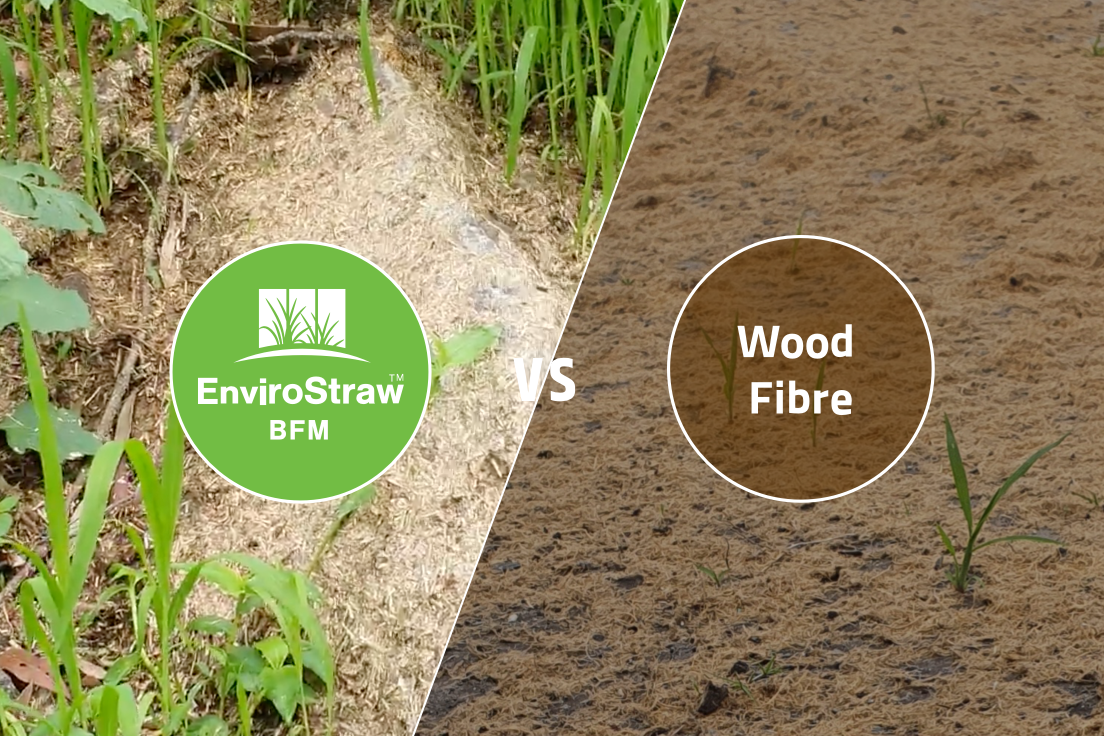From wood fibre to straw, its materials are more effective at retaining moisture and preventing erosion. Hydromulch is used in a variety of industries, including construction, mining, and forestry, for a wide range of applications, including erosion control, revegetation, and soil stock pile stabilisation.
This shift to sustainable products like Straw Fibre is important for a number of reasons. It’s more environmentally friendly than traditional hydromulch, and it doesn’t produce the volume of harmful pollutants during its production.
It’s also more effective at preventing erosion and revegetating land because it contains more organic matter, which helps to improve soil health and soil water retention that provides a favourable environment for seed germination and plant growth.
Wood hydromulch has previously been used in the industry as an environmentally friendly and effective product as it is made from wood fibres, which are a renewable resource. It’s also been shown to be effective in retaining moisture and preventing erosion and is biodegradable.
However, wood hydromulch also has a number of negative consequences. It’s expensive to process and impacts sustainability, as it requires cutting down trees to harvest the wood chips.
In the search for a more sustainable solution, recent advancements have led to a superior option in straw hydromulch, which is made from renewable materials and doesn’t lead to deforestation.
Straw is not only the better choice from a sustainability point of view, but it also excels in coverage, seed protection, and soil moisture retention, setting new standards in erosion control.
The benefits of straw over wood:
- Straw is inherently renewable, sourced from crops like oats and cereal and considered a by-product of farming, whereas wood fibre-based hydromulch takes up to 20 years to grow
- Straw-based hydromulch has been shown to perform as well if not better than wood fibre hydromulch in terms of erosion control, especially on steep slopes. Independent testing by Landloch Laboratories of our EnviroMatrix Erosion Control Matrix and Biotic Growth Amendment + EnviroBond showed outstanding results with increased slope lengths providing increased erosion control over some wood fibre products (refer to the table below)

- Straw-based hydromulch provides better coverage per tank and requires less water than wood-fibre hydromulch because straw has improved WAE (water use efficiency) than wood fibre. For example, when 48 bales per tank of EnviroStraws BFM are used, the area covered is 3,200 m2, and the water required per hectare is 35,203 lt. At 24 bales per tank of Australian manufactured wood fibre hydromulch covers 1,600m2, however requires an astounding 68,136 lt per hectare
Note – mix rates and coverage areas are based on market feedback and manufacturers recommendations. Application rate 3,000 kilograms for BFM Bonded Fibre Matrix Hydromulch. Machine size = 11,356 lt.
- For contractors and site owners, the advantages of straw-based hydromulch go beyond environmental benefits. Its cost-effectiveness shines through reduced water usage, overall resource and maintenance cost reduction, ease of application and increased on-site productivity
- When using EnviroStraw’s all-in-one products like BFM Complete and EnviroMatrix, on-site compliance becomes effortless. Simply count the bales going into the hydromulch tank, add the seed, and spray – it couldn’t be simpler.
If you’re looking for the most superior hydromulch product on the market, give the EnviroStraw team a call on 1300 868 669 today.
